Using M-blocks, MIT researchers have created a robotic technology that features cubes with no external moving parts, yet are fully capable of propelling themselves forward, jumping atop one another, and rolling across the ground.
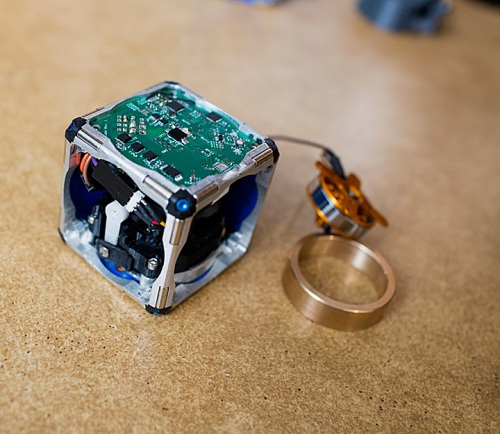
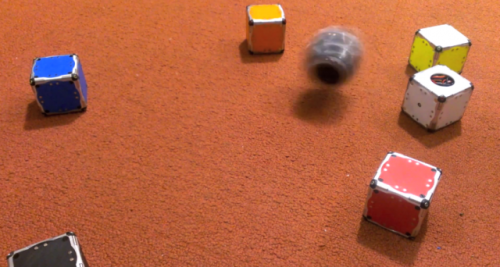
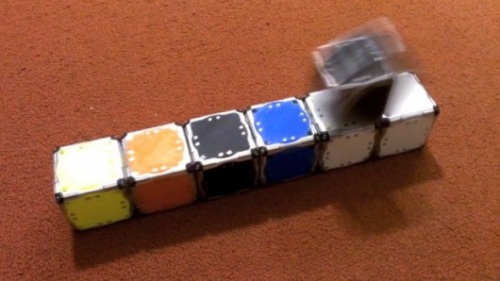
The group that worked on the project includes former MIT student John Romanishin, MIT robotics / electrical engineering professor Daniela Rus, and postdoc Kyle Gilpin.
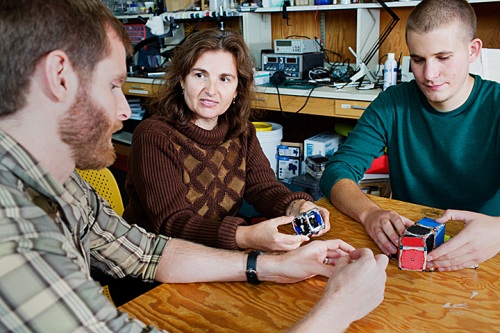
From left to right: Kyle Gilpin, Daniela Rus, and John Romanishin.
They will present a paper describing their new robots at the upcoming IEEE/RSJ International Conference on Intelligent Robots and Systems.
The way in which the technology works is surprisingly simple: each block is essentially a flywheel that has the ability to reach speeds of 20,000 revolutions per minute. When the flywheel is braked, it imparts angular momentum on the cube, and on every face of the M-block are strategically located permanent magnets that allow any two cubes to fly into and attach to one another.
Specifically, on each edge of a cube are cylindrical magnets, which are mounted like rolling pins. When two cubes approach one another, the magnets naturally rotate so that north poles align with south, and vice versa.
To secure the blocks’ grip to one another, the edges of the M-blocks are beveled. When two cubes are face to face with one another, there’s a bit of a gap between the magnets, but when one flips on top of the other, the bevels, and thus the magnets, touch, thereby making the connection between the cubes much stronger.
Further strengthening the bond are four pairs of smaller magnets, arranged symmetrically on the face of the cube, which help snap a moving M-block into place when it lands atop the other.
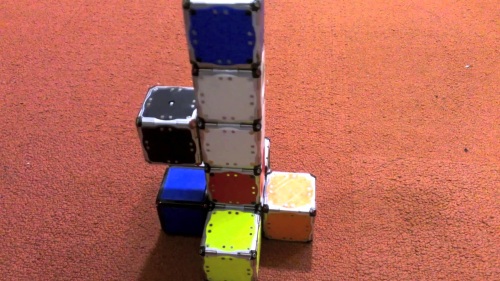
“It’s one of those things that you kick yourself for not thinking of,” said Hod Lipson, a colleague of Rus’ who is herself a robotics researcher at Cornell. “It’s a low-tech solution to a problem that people have been trying to solve with extraordinarily high-tech approaches.”
“What they did that was very interesting is they showed several modes of locomotion,” she adds. “Not just one cube flipping around, but multiple cubes working together, multiple cubes moving other cubes — a lot of other modes of motion that really open the door to many, many applications, much beyond what people usually consider when they talk about self-assembly. They rarely think about parts dragging other parts — this kind of cooperative group behavior.”
Learn more about the story behind the M-block technology in the video below:
Looking ahead, the group hopes that these modules can be made smaller, with the ultimate goal being to have hordes of swarming microbots that can self-assemble, a la the liquid steel androids in the movie, “Terminator II.”

But that’s way down the road — there is immediate potential for this technology as it exists today. Armies of these M-blocks could be used to repair buildings or bridges during emergencies, or raise and reconfigure scaffolding for building projects. They could self-assemble into furniture or heavy equipment, or be used to go into hostile / inaccessible environments, whereupon they can reassemble to assess the situation (with attached cameras) and provide solutions (provide light, battery power, etc.)
For now, though, the MIT group is developing an army of 100 cubes, each of which can move in any direction, and designing algorithms to guide them.
“We want hundreds of cubes, scattered randomly across the floor, to be able to identify each other, coalesce, and autonomously transform into a chair, or a ladder, or a desk, on demand,” Romanishin says.
Story via: mit.edu
Advertisement





